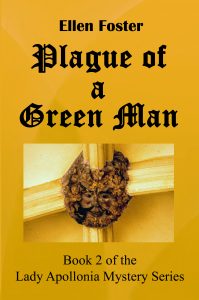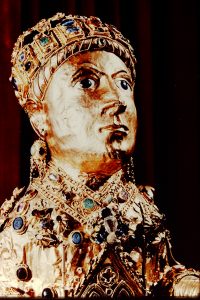 My novels are set in the West Country of medieval England, so it is necessary that I use some terms and expressions that are peculiar to that period. Many are familiar to us in the 21st century but had medieval meanings which we no longer use. I would like to comment on several of these terms that appear in my second book in the Lady Apollonia Mystery Series, Plague of a Green Man, the cover of which appears on the left.
My novels are set in the West Country of medieval England, so it is necessary that I use some terms and expressions that are peculiar to that period. Many are familiar to us in the 21st century but had medieval meanings which we no longer use. I would like to comment on several of these terms that appear in my second book in the Lady Apollonia Mystery Series, Plague of a Green Man, the cover of which appears on the left.
My heroine and her second husband were in the woolen trade, a vastly important part of the medieval economy, and this required the use of specific terms relevant to the trade. My story is set in Exeter, Devon, where an official of the woolen trade called the “aulnage” had his residence. The aulnage was a royal official whose duty was to examine all cloth offered for sale and see that it conformed to the requirements of English law. Not surprisingly, that official becomes one of the characters in my story. I also use the phrase: “the cloth of assize”. That was cloth measuring 24 twenty-four yards by two yards which was used as a standard.
Another important character in this story and my other novels is Bandon Landow, a Pardoner, or an ecclesiastical official charged with the granting of Indulgences. An Indulgence is a document containing a partial remission of punishment in purgatory, still due for sin after one’s absolution. The medieval church saw itself able to offer Indulgences because of its control of something called the Treasury of Merit, defined in the medieval church as a treasury of the goodness and merits of Christ and all the saints, left in the keeping of the Church. In the later Middle Ages, the sale of indulgences became a significant means of raising funds.
Brandon Landow is based somewhat on Geoffrey Chaucer’s Pardoner in The Canterbury Tales. Brandon is a devious person who is more interested in enriching himself than in serving the church in which he holds clerical status. He did this by selling fake relics and reliquaries in addition to the indulgences mentioned above. Relics in the medieval church were an ecclesiastical term referring to the body, a part of the body or a personal memorial of a saint or members of the Holy Family regarded as worthy of veneration. Ancient churches always offered a series of important relics where believers could come and pray. These relics were often a bodypart of a saint, an item which had belonged to a saint, or even the blood of Christ. It was believed that such relics were the physic remains of a holy person through whom a sinner could seek God’s help. Many churches included a “reliquary”, a beautifully crafted receptacle for a relic where the believer could kneel and pray for such intervention. The jeweled reliquary of Saint Foy, which is over a thousand years old, can be found in Conques, France. It is shown on the right.
A minor character in the story of this book is a “doctor of physic” where physic, in the 14th century, is any medicine or drug, especially one that purges. The term “doctor of physic” in the medieval period, referred to a highly regarded and successful medical practitioner.
Another important disease term which appears in this and in several of my other novels is leprosy. This word was not well defined in the medieval period and was applied to many diseases of the skin. In Plague of a Green Man, I also refer to the “mass of separation”. This was a mass, spoken by a priest, performed at a leper’s hut, forbidding him or her to have any human contact in religious or human society, to drink at any stream or fountain, or to touch anything belonging to another human being. Medieval society ostracized anyone who was deemed to be a leper.
 Finally, I want to comment on the term “sanctuary” which plays an important role in my story. We think of the word as designating a special place for worship, but it had another important meaning in the medieval period. Sanctuary was a holy place where fugitives could seek refuge and were entitled to find immunity from arrest. Two of my villains seek such refuge in Exeter Cathedral.
Finally, I want to comment on the term “sanctuary” which plays an important role in my story. We think of the word as designating a special place for worship, but it had another important meaning in the medieval period. Sanctuary was a holy place where fugitives could seek refuge and were entitled to find immunity from arrest. Two of my villains seek such refuge in Exeter Cathedral.
I include such period definitions and terms in the glossary at the end of each novel so that my readers may understand and feel themselves returned to a time centuries ago.